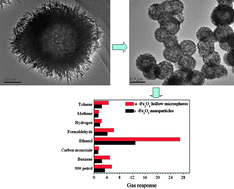Flexible morphology-controlled synthesis of monodisperse α-Fe2O3 hierarchical hollow microspheres and their gas-sensing properties
Abstract
Microspheres constructed with α-FeOOH

* Corresponding authors
a
School of Materials Science and Engineering, Jiangsu University, Zhenjiang, Jiangsu, China
E-mail:
songhj@ujs.edu.cn
Fax: +86-511-88780191
Tel: +86-511-88797049
b School of the Environment, Jiangsu University, Zhenjiang, Jiangsu, China
Microspheres constructed with α-FeOOH

 Please wait while we load your content...
Something went wrong. Try again?
Please wait while we load your content...
Something went wrong. Try again?
H. Song, X. Jia, H. Qi, X. Yang, H. Tang and C. Min, J. Mater. Chem., 2012, 22, 3508 DOI: 10.1039/C2JM13574D
To request permission to reproduce material from this article, please go to the Copyright Clearance Center request page.
If you are an author contributing to an RSC publication, you do not need to request permission provided correct acknowledgement is given.
If you are the author of this article, you do not need to request permission to reproduce figures and diagrams provided correct acknowledgement is given. If you want to reproduce the whole article in a third-party publication (excluding your thesis/dissertation for which permission is not required) please go to the Copyright Clearance Center request page.
Read more about how to correctly acknowledge RSC content.
 Fetching data from CrossRef.
Fetching data from CrossRef.
This may take some time to load.
Loading related content
